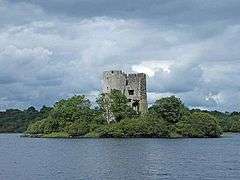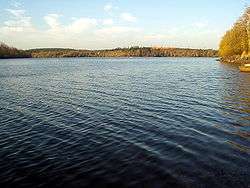Cloughoughter Castle
Cloughoughter Castle is a ruined circular castle on a small island in Lough Oughter, 4 kilometres (2.5 mi) east of the town of Killeshandra in County Cavan, Ireland.
| Cloughoughter Castle | |
|---|---|
 Cloughoughter Castle sits on an island in Lough Oughter | |
 Location within Ireland | |
| General information | |
| Location | Lough Oughter, Cavan |
| Country | Ireland |
| Coordinates | 54.018744°N 7.454800°W |
| Construction started | 1200 - 1224 |
| Demolished | 1653 |
| Client | William Gorm de Lacy |
National Monument of Ireland | |
| Reference no. | 602 |
History

The castle is located in the historic Kingdom of Breifne, specifically in the part that would later be subdivided into East Breifne, roughly corresponding to County Cavan. Prior to the construction of the castle, the spot may have been a crannóg. In the latter part of the 12th century, it was under the control of the O'Rourkes, but it seems to have come into the hands of the Anglo-Norman William Gorm de Lacy after the Normans wrest control of some of the territory from that ruling clan. While the exact date construction began is unknown, it is estimated to have started in the first quarter of the 13th century. Architectural elements date the lower two storeys of cloughoughter to this time.[1]
In 1233, the O'Reilly clan took possession of the area and completed the castle. They retained it for centuries in the midst of their ongoing conflicts with the O'Rourkes and with members of their own clan. It was there that Philip O'Reilly was imprisoned in the 1360s with "no allowance save a sheaf of oats for day and night and a cup of water, so that he was compelled to drink his own urine."[1]
After the Plantations
Possession of Cloughoughter was granted to servitor Hugh Culme during the Plantation of Ulster. Culme did not dwell in the castle, but built a new residence upon the nearby lake shore.
Philip O'Reilly, then an MP for Cavan and leader of the rebels during the Irish Rebellion of 1641 seized control of the castle, retaining it as an island fortification for a further 12 years. During this final phase of its active existence, it was used as a prison.[1] In this capacity Culme was imprisoned having failed to defend it as he had been charged.
The Anglican Bishop of Kilmore, William Bedell was also held there for a period of weeks and died soon afterwards in February 1642, evidently due to inadequate shelter from the cold winter.[2][3]
In 1649 Owen Roe O'Neill, the commander of the Ulster Army died at the castle. For the remaining years of the rebellion, O'Reilly retained it as an island fortification, holding it a total of 12 years before it was besieged. Finally, The British Cromwellian forces had defeated the surrounding indigenous Irish armies, pushed the defenses back to the lake, recovered the lake-shore and proceeded to bombard the castle from positions in the townland of Innishconnell. When the castle finally fell and the indigenous Irish captured in March 1653, it was the last remaining rebel stronghold, fell to Cromwellian forces in March 1653, but not easily. Due to its island location, invading troops set up their cannons on a rise, at some considerable distance, in the townland of Innishconnell. The castle's walls were breached by cannon shot, remain to this day.[1][3]
Left in ruins, the castle became a frequent subject of art in the 18th and 19th centuries.[1] Its visual impact was described in a travelogue published The Dublin University Magazine in 1852:
It stands on a small island, scarce three hundred feet in diameter, just sufficient to contain the castle and a small margin of rock around it. The island stands in very deep water; the shores are a mile distant, wild, yet thickly wooded. The castle is a beautiful ruin, round, massive, hoary, save where mantled with rich Irish ivy. The walls are immensely thick, with embrasures and coved windows, round which "ruin greenly dwells." It is unlike most Irish castles, which are square.[4]
Conservation efforts were begun on the castle in 1987.[1][5]
References
- - Ireland's Eye.com, Cloughoughter Castle
- McCullam, R. (1856). Sketches of the Highlands of Cavan, and of Shirley Castle, in Farney, taken during the Irish famine. J. Reed. p. 207. Retrieved 29 March 2011.
- Religious Tract Society (1885). The Sunday at Jome. Religious Tract Society. p. 747. Retrieved 29 March 2011.
- Curry, William; Jun. & Co (1852). The Dublin University magazine. William Curry, Jun., and Co. p. 519. Retrieved 29 March 2011.
- Archived 2011-02-26 at the Wayback Machine - Explore Cavan, Cloughoughter
